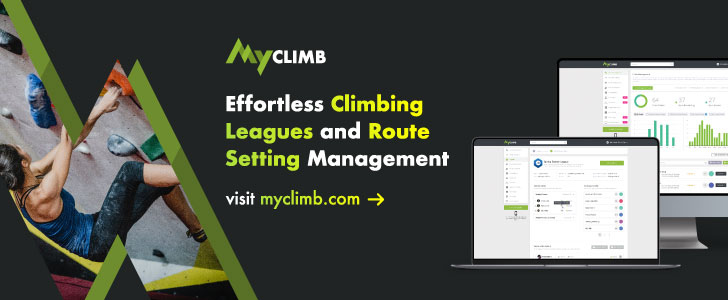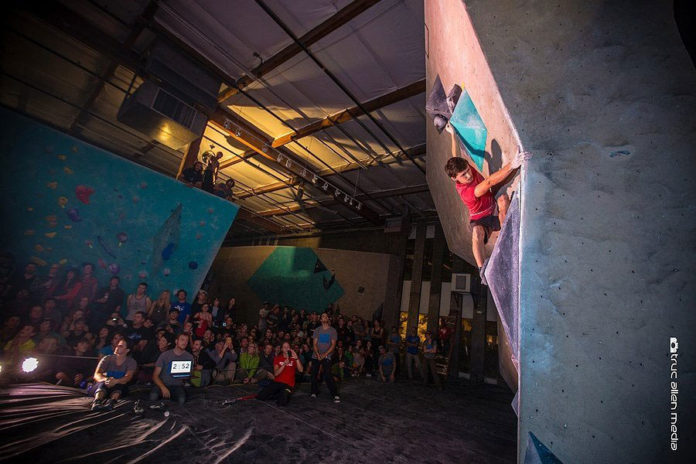
Behind the Wrench…is an ongoing series that interviews the “rock stars” of the climbing industry: the routesetters at the gyms. We recently heard from several readers requesting that we feature Simon Parton in an installment of Behind the Wrench. Parton is one of the most accomplished routesetters on the Canadian scene, so we were happy to oblige. (If you’ve got a routesetter that you’d like to see featured, feel free to drop us a line and tell us about the person).
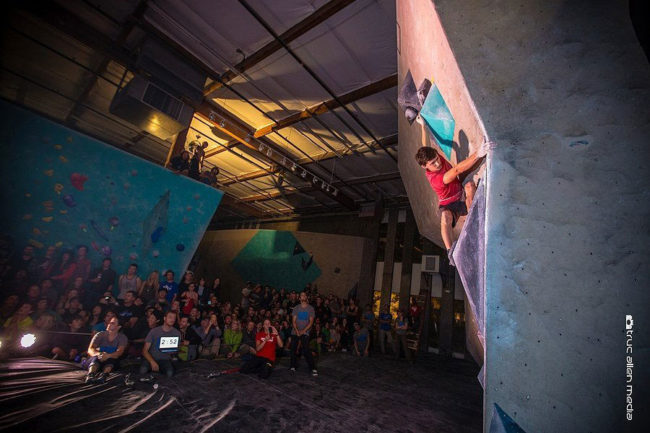
Name: Simon Parton
Title: National Competition Chief Routesetter
Home Gym: Project Climbing
Location: Vancouver, British Columbia
CBJ: I’ve read that you were part of the Edge Climbing Team (and Canadian National Team) as a kid. But going back further than all that—how did you first become interested in climbing? And what was it about the activity that hooked you?
PARTON: In ‘97 or 98’ I did a week-long camp at the Edge Climbing Centre. We learned to belay, climb, and at the end of the week we hiked up a local mountain. It was so much fun…doing something physical, being up high, swinging around. I started climbing regularly in ’99. Recently [in the spring of 2020], I took my first six weeks off of climbing since I started—for reasons we all are tired of hearing about.
I had always been athletic growing up; I could throw the thing, kick the thing, jump over the thing. So I fell in love with the physical challenge of climbing right away. All of a sudden there was a clear obstacle, a pretty basic, seemingly reasonable physical challenge I couldn’t do. Just climb to the top. Trees sure, but that’s not hard, just sketchy. At The Edge there was this wall called the main cave. It’s basically a 30-foot wall that’s 45-degrees with a roof at the end. I couldn’t do it—using any holds, couldn’t do it. The constant challenge was enough to hook me in. The mental side of climbing came to me when I was a little older and a couple years into a competition career.
CBJ: The competition circuit has really grown a lot in the past few years…it’s now way more popular, robust, etc. How was your comp traveling as a kid perhaps different from what it’s like for national team members to travel and compete nowadays?
PARTON: As you say, the competition circuit has definitely grown. But to the credit of the coaches I had when I was on the youth national team, in a positive way, not much has changed in terms of being a national team member. The pressure is still there, the expectation of professionalism is still there, the months and months of preparation and training are still there. Most Canadian team athletes are focused on one big competition at the end of their season. So at its core, going to a big event and competing is still a very similar experience—even if the events are bigger now and getting there is a little more complicated.
But, ‘back in my day’ on the youth national team (2005-2007), the Youth World Championships, or even our Youth National Championships, didn’t have bouldering; we only had lead and speed, and no one trained for speed. We still did it, but it was something we did as a distraction from the pressure of lead. Athletes now have a choice of three disciplines, and they aren’t always willing to specialize, especially before all the Olympic spots are finalized. The demands of a multi-discipline athlete to train throughout the year and also perform 2-3 times as much as other athletes on the same weekend is much more difficult.
The biggest change is probably the Open national team. There basically was no consistent national team before the mid 2010s-ish. We made the trip down to Vail [Colorado] for the World Cup every year starting in 2008. But beyond that if you wanted to compete internationally you were on your own. Now both the Youth and Open national team get lots of support throughout the year.
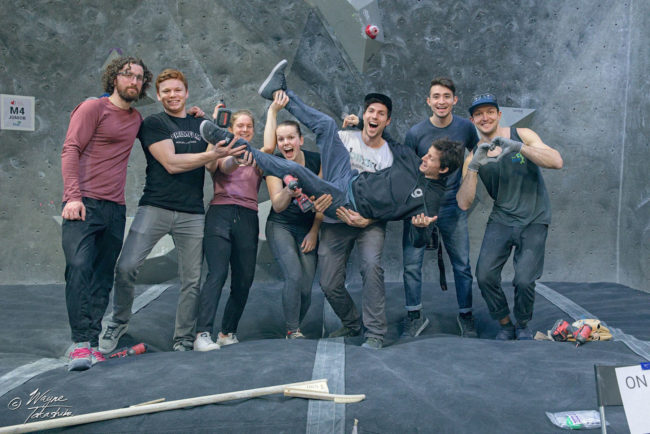
CBJ: Let’s switch gears to routesetting. How would you describe your vision for routesetting and what do you ultimately hope to get out of a career as a routesetter?
PARTON: I would hope to continue doing what I’m doing and build on that. My passion is definitely with the competition/athlete development side of routesetting. Each year I’m fortunate enough to do about 10-15 sanctioned events from the local level up to the national level, and if it’s a good year one or two international events. I get to see how athletes progress from each level, why they progress, and why they might not.
Over time, I began to recognize the potential of how setters can contribute to athlete development. Routesetters are the only people in a competition who have any effect on the field of play and we have complete control over it. That’s an enormous amount of power and responsibility, and setters don’t always recognize it or understand it. Anything that is put on the wall makes a statement about what is fair and what is expected of the athletes in the current and next level of competition. This is true of climbing gyms as well, though less specific in that case.
As an example, when I am chief for a local competition, one of my many basic questions to the competitors is: “Are you ready for Provincials?”. Then, two weeks later when I’m chief at Provincials, I’m asking “Are you ready for Regionals?” It carries on—regionals, nationals, national team selection camp, and finally to IFSC competitions. Every time preparing athletes, becoming a sort of gatekeeper at each level. Understanding that if I don’t ask the right questions of the athletes, they might not progress as they should, or may not be able to maximize their future success.
I would love to train competition setters more often, focus more on the performance-style of routesetting, and continue doing the high-level events that I do. For me, nothing beats the feeling I get of pride, relief and exhaustion after a well-set competition. It’s hard work, but it’s where I feel at home.
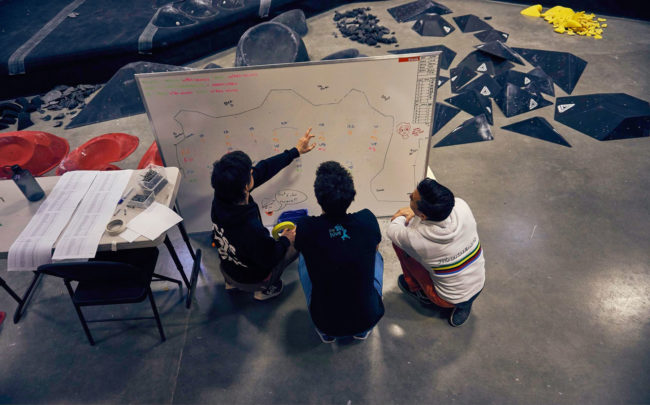
CBJ: What personal qualities do you think make for a good routesetter? Not all great climbers are great routesetters, and vice versa, right?
PARTON: Specifically regarding the great climber/great routesetter conundrum: the ability to see things clearly in your head is probably one of the most important things that might be missing when making the transition from great climber to great routesetter. You have to be able to stare at a blank wall and see at least a couple different possible movements at once. You have to be able to copy and paste a climber of any size and ability onto any part of the boulder and watch them climb.
Then, of course, your vision has to match what would happen in reality, but that comes with experience. Creating things in your head and moving them around at will in your head is a big one, and it’s honestly the hardest skill to develop if it doesn’t come naturally. I might argue for fun and say that all great routesetters are great climbers. Relatively speaking, I know a lot of great routesetters and the one thing they all have in common is an exceptional mental map of an extensive range of climbing movement. This almost always transitions to very good personal climbing technique, which you might define as a great climber.
CBJ: What’s the “perfect route,” in your opinion?
PARTON: The easy answer is that a perfect route does exactly what it was designed to do. Everything is set for a purpose. Sometimes that purpose is as broad as the wall was empty and it needed to be filled with something interesting; or as specific as—I have to separate six elite youth B girls who are all equal in ability in opposite ways and all different heights.
For example, I’ve set terrible routes on purpose that I would consider perfect. A reoccurring exercise in athlete training camps is to help them learn how to focus and be confident through ugly/uncomfortable routes. If I see athletes starting to get frustrated and their performance drops, task completed, that’s a perfect route.
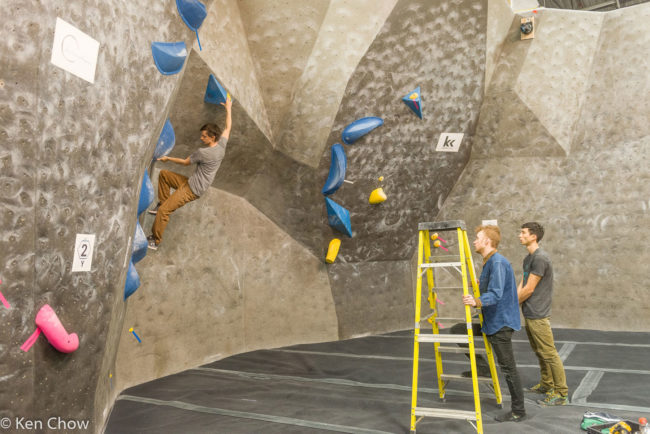
CBJ: You’ve set at a number of gyms over the years…are there things that you wish more gyms did to foster routesetting as a viable career?
PARTON: Man, oh man—there are so many obstacles that are currently stopping routesetting from becoming a more accessible career. It’s hard to pick one; they are all directly linked. Most routesetters can’t make a decent living. In too many cases the job is still on par with a restaurant dishwasher: poor pay, and they aren’t around for very long. The routesetters either leave or change gyms—so those routesetters don’t get the training they need because they leave, because they don’t get compensated.
We’ve all just got to hit pause on the cycle, raise the bar a little—but we’ve got to raise it together. There are routesetters out there with potential who want to do this long term; they aren’t hard to find, we’ve just got to give them a chance through training, appropriate compensation, and a little respect. The negative stories are always louder than the positive ones, so of course there are some exceptional places to work out there. I just want more of them for all of us routesetters. This job is already very difficult; it doesn’t need to be any harder.

CBJ: There were a number of new gyms that opened in Canada in 2020. To what do you attribute such positive growth for climbing in Canada, specifically?
PARTON: This is probably true of the growth of climbing gyms anywhere, but workouts are grueling slogs. Climbing is a perfect distracted-workout. Unless you are doing proper regimented climbing training, you can’t beat it. People want to be fit and active—believe it or not, they do want that. But most active things feel like work. Playing a sports team-game can be fun, but you need 20 people to be organized. Bouldering, especially, is such an easy and accessible adventure. Social media, as well, is making climbing become a little less scary, a little less extreme, and more accessible. I think we will be growing for the next while.
CBJ: In your opinion as a routesetter, are the United States and Canadian climbing gym scenes different at all? Is there any nuance that differentiates the two?
PARTON: I think it’s even more specific than the United States and Canada. Traveling province-to-province, I see huge differences. I see it especially well at national events. The athletes from each province are often a direct reflection of the community they’ve come from. It’s probably safe to say that it’s the same story state-to-state. I can’t say I’ve been to too many U.S. climbing gyms just to climb. I usually comp set, compete, or drive by on the way to a climbing destination. But, as an observer, the size of the gym and its proximity to an outdoor area is going to have the most influence on a gym scene rather than nationality. Bigger gyms, which the U.S. has far more on average, tend to have broader targeted routesetting, searching for more of a mass appeal.

John Burgman is the author of High Drama, a book that chronicles the history of American competition climbing. He is a Fulbright journalism grant recipient and a former magazine editor. He holds a master’s degree from New York University and bachelor’s degree from Miami University. In addition to writing, he coaches a youth bouldering team. Follow him on Twitter @John_Burgman and Instagram @jbclimbs. Read our interview Meet John Burgman, U.S. Comp Climbing’s Top Journalist.




